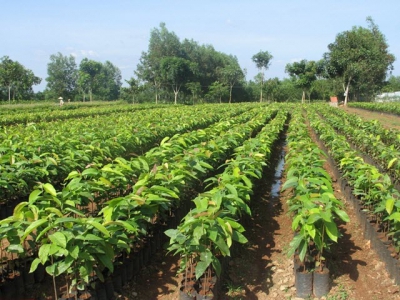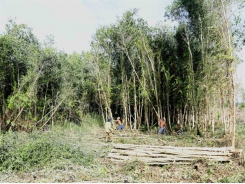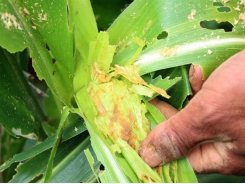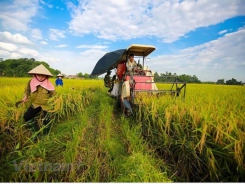Vietnam seeks to develop agricultural species based on market demand

The scheme to develop agricultural plant and forest tree varieties, livestock breeds and aquatic strains, approved by the prime minister in 2009, has yielded positive results in its first decade of implementation. However, implementation has focused on rice varieties but not on market demand, and Vietnam still has to import many kinds of agricultural products.
Initial results
In 2009, the Thuy Phuong Pig Research and Development Center received permission from the Ministry of Agriculture and Rural Development (MARD) to expand its research facility and import genes to create Vietnamese pig breeds of high quality and productivity.
Nguyen Quy Khiem, Director of the Thuy Phuong Pig Research and Development Center, said the center had used the project budget for the 2009-2015 period to build a major pig breeding facility in Hoa Binh Province's Ky Son District. The facility has sufficient space to rear 350 sows. The center has imported high-productivity pedigree pigs for this facility, including 250 sows and 40 boars (Landrace, Yorkshire and Duroc breeds) from France, the US and Canada.
So far, the center has increased the number of pedigree sows to 350 in Ky Son District and 800 at the Tam Diep facility. Based on imported breeds, the center continues to research the creation of high-productivity Vietnamese pig breeds.
Another project undertaken by the Dai Xuyen Duck Research Center under the National Institute of Animal Sciences seeks to create and supply quality ducks and geese in order to prevent the illegal import of ducklings of unclear origin. According to the Dai Xuyen Duck Research Center, the center has used the project's budget to modernize research and breeding facilities. From 2012-2018, the center imported 4,806 baby ducks and geese from the UK and France. It has supplied 896,400 pedigree ducks and 137,088 pedigree geese, generating millions of commercial ducks and geese.
According to Nguyen Van Viet, Director of the MARD's Planning Department, from 2010-2018, nearly 1,000 new plant varieties and livestock breeds were put into production nationwide, resulting in a 15 percent increase in the yields of various kinds of plants and livestock and a 50 percent increase in forest plantation productivity. The average live body weight of mature pigs increased by 32 percent; and milk yields also increased by 200-300kg per head of cattle per cycle.
However, Nguyen Van Viet said research activities still focus on short-day plant varieties and fast-growing livestock breeds. The cultivation sector has concentrated mostly on creating new varieties of rice and maize but not vegetables and fruit. No new variety of pepper has been created over the past 10 years.

Following market demand
From now to 2030, the MARD is seeking to enhance research capability and the creation and management of agricultural plant and forest tree varieties, livestock breeds and aquatic strains in order to increase their added value and promote sustainable development of the agro-forestry-fishery sector. Specifically, its goals are to ensure that 90 percent of rice seeds used for mass cultivation are F1 hybrid, and that long-day industrial crops and fruit trees derived from original ortets account for 90 percent of these plants (50 percent for pepper). Other goals include having 70-80 percent of new forest tree species recognized and put into cultivation; 80 percent of new cattle breeds used for meat production, 95 percent of new pig breeds and 90 percent of new poultry. In addition, the ministry wants all the demand for aquaculture breeds sourced domestically.
To achieve these targets, the MARD encourages investment in plant and livestock production to create three major groups of products: (1) key national products with annual export value of US$1 billion or higher, pork and poultry; (2) key products of localities; and (3) specialties of localities. Further research should be promoted to create new, high-quality and high-yield plant varieties that are resistant to insects and diseases and adaptable to climate change.
Minister of Agriculture and Rural Development Nguyen Xuan Cuong emphasized that agricultural production will be ineffective if not based on market demand. For example, Ninh Thuan and Binh Thuan provinces should examine the options in desert farming; Mekong Delta localities should be associated with brine and brackish water aquaculture, while northwestern provinces should shift from maize cultivation to planting fruit trees and medicinal herbs.
Minister Nguyen Xuan Cuong said the MARD would prepare an agricultural species development scheme for the new period and submit it to the government for approval. The new scheme will be based on market demand, focusing on three sectors: forestry, fisheries and agriculture.
Minister of Agriculture and Rural Development Nguyen Xuan Cuong:
To restructure the agricultural sector successfully from now until 2030, especially in the context of the complex climate change developments, the MARD has asked the prime minister for permission to prepare a scheme to develop agricultural plant and forest tree varieties, livestock breeds and aquatic strains in the 2021-2030 period.
Có thể bạn quan tâm
Phần mềm

Phối trộn thức ăn chăn nuôi

Pha dung dịch thủy canh

Định mức cho tôm ăn

Phối trộn phân bón NPK

Xác định tỷ lệ tôm sống

Chuyển đổi đơn vị phân bón

Xác định công suất sục khí

Chuyển đổi đơn vị tôm

Tính diện tích nhà kính

Tính thể tích ao hồ



 Vietnamese company exports bamboo drinking straws
Vietnamese company exports bamboo drinking straws  Ca Mau adjust list of key local agricultural…
Ca Mau adjust list of key local agricultural…